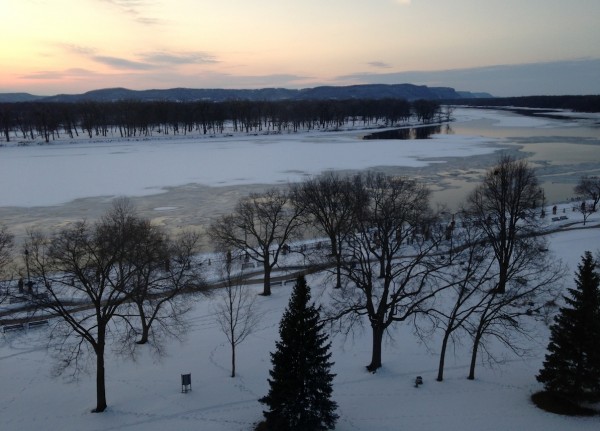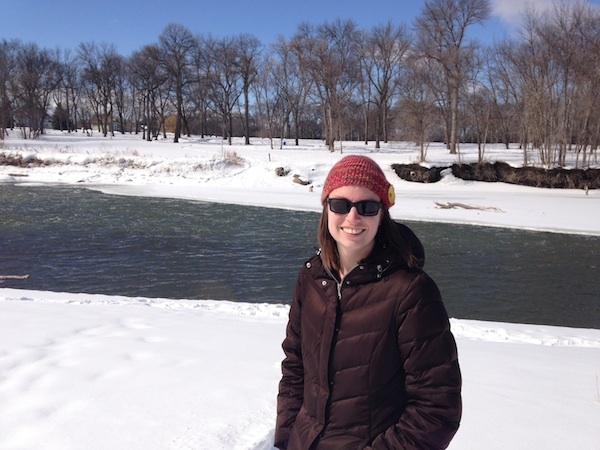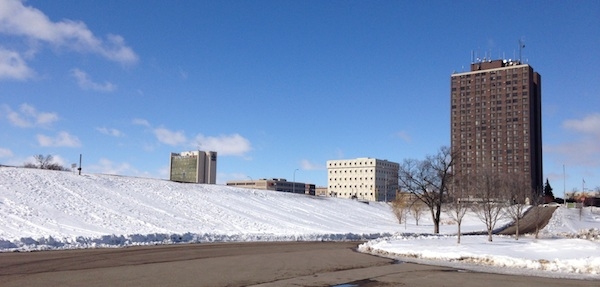![]() It’s been another month of fascinating scientific adventures for your resident hydrologist.
It’s been another month of fascinating scientific adventures for your resident hydrologist.
It all began at the end of February, when I travelled to La Crosse, Wisconsin to the Upper Midwest Stream Restoration Symposium, which was a really stimulating and vital mix of academics, consultants, and government folks all interested in improving the state of the science and practice of stream restoration. I gave a talk on Evaluating the success of urban stream restoration in an ecosystem services context, which was my first time talking about some hot-off-the-presses UNCC graduate student research, and I learned a lot from the other speakers and poster presenters. While the conference was incredibly stimulating, travel delays due to bad weather on both ends of my trip made for a somewhat grumpy Anne (nobody really wants to spend their birthday stuck in a blizzard in O’Hare), so I’ll be thinking carefully about how to plan my travel to the Upper Midwest during future winters. Nonetheless, the view from the conference venue was phenomenal.

View of the Mississippi River from the Upper Midwest Stream Restoration Symposium in La Crosse, WI. Not shown: bald eagles that frequent the open water patches of the river.
March proper saw me give variations of the restoration talk two other times. On the 15th, I gave it as the seminar for Kent State’s Biological Sciences department, and on the 26th, I gave it at the North Dakota State University Department of Geosciences (more about that trip below). In between, I gave a seminar on the co-evolution of hydrology and topography to the Geology Department at Denison University in Granville, Ohio. Students in that department had just returned from a trip to Hawaii, and a very memorable dialogue occured in the midst of me talking about the High Cascades:
“You’ve seen a young lava flow. What would happen if you poured a bottle of water on it?” “It would steam!” “Not that young!”
Closer to home I also hosted a couple of prospective graduate students, helped interview candidates for a faculty position in our department, and went with a colleague to visit an acid mine drainage site about an hour to the south of Kent. In one fairly small watershed, we were able to tour a number of different remediated and unremediated sites, and it certainly lent a whole different perspective to the ideas of stream restoration and constructed wetlands to look at a landscape irrevocably scarred by mining activities.

Constructed wetland as the second stage of acid mine drainage remediation in the Huff Run watershed.
At the end of the month, we finally got our turn for spring break. I ended up with a somewhat epic combination of mounds of work and a big trip to take, possibly the worst combination of the untenured and tenured professor spring break stereotypes (see this PhD comics strip). The first half of the week, I spent in Fargo, North Dakota, home to the famously flood-prone Red River of the North. (I’ve blogged before about why the river so often produces expansive floods.) It was truly fascinating to put my feet on the ground in a place that I’ve read about and watched from afar for years. And my visit was made all the more interesting by my host and guide, Dr. Stephanie Day, a geomorphologist newly at NDSU and who may well unravel some of the Red’s geomorphological peculiarities.

Stephanie Day, Assistant Professor of Geosciences at North Dakota State University beside the Red River in Moorhead Minnesota. The flat surface in the background is the approximate elevation of the land for miles around.

River’s edge view looking towards downtown Fargo. Snow well over knee deep here on 25 March, by my measurements. As all that snow starts to melt, the water will rise.
There’s a pretty good chance we’ll see a major flood on the Red River later this spring, as the >24″ of snow melts out of the watershed, runs off over frozen ground, and enters the northward flowing river. The Fargo Flood page is the place to go to follow the action, and you can count on updates (and more pictures) here as events unfold.
The latter half of my spring break saw me diagonal across the state of Minnesota to my beloved Driftless Area, back across the Mississippi River, and into the state of Wisconsin. I saw my family, finished paper revisions, and wrote part of a grant proposal. Then I flew home, with nary a weather delay in sight.
If March was a tight, recursive meander of talks and trips to the Upper Midwest, then April promises to be a bit anastomosing with lots of different threads woven together to make another month of scientific delight.





Comments (2)
Links (1)-
Pingback: March Meanderings